美国FDA指南 中文版
美国FDA生产过程(工艺)验证总则指南中英文版
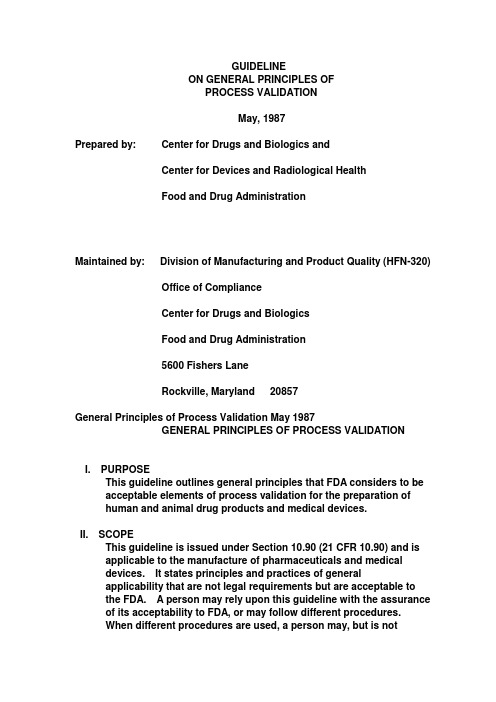
GUIDELINEON GENERAL PRINCIPLES OFPROCESS VALIDATIONMay, 1987Prepared by: Center for Drugs and Biologics andCenter for Devices and Radiological HealthFood and Drug AdministrationMaintained by: Division of Manufacturing and Product Quality (HFN-320)Office of ComplianceCenter for Drugs and BiologicsFood and Drug Administration5600 Fishers LaneRockville, Maryland 20857General Principles of Process Validation May 1987GENERAL PRINCIPLES OF PROCESS VALIDATIONI. PURPOSEThis guideline outlines general principles that FDA considers to beacceptable elements of process validation for the preparation ofhuman and animal drug products and medical devices.II. SCOPEThis guideline is issued under Section 10.90 (21 CFR 10.90) and isapplicable to the manufacture of pharmaceuticals and medicaldevices. It states principles and practices of generalapplicability that are not legal requirements but are acceptable tothe FDA. A person may rely upon this guideline with the assurance of its acceptability to FDA, or may follow different procedures.When different procedures are used, a person may, but is notrequired to, discuss the matter in advance with FDA to prevent theexpenditure of money and effort on activities that may later bedetermined to be unacceptable. In short, this guideline listsprinciples and practices which are acceptable to the FDA for theprocess validation of drug products and medical devices; it doesnot list the principles and practices that must, in all instances,be used to comply with law.-1-This guideline may be amended from time to time. Interestedpersons are invited to submit comments on this document and anysubsequent revisions. Written comments should be submitted to the Dockets Management Branch (HFA-305), Food and Drug Administration,Room 4-62, 5600 Fishers Lane, Rockville, Maryland 20857. Receivedcomments may be seen in that office between 9\a.m. and 4\p.m.,Monday through Friday.III. INTRODUCTIONProcess validation is a requirement of the Current GoodManufacturing Practices Regulations for Finished Pharmaceuticals,21 CFR Parts 210 and 211, and of the Good Manufacturing PracticeRegulations for Medical Devices, 21 CFR Part 820, and therefore, isapplicable to the manufacture of pharamaceuticals and medicaldevices.Several firms have asked FDA for specific guidance on what FDAexpects firms to do to assure compliance with the requirements forprocess validation. This guideline discusses process validationelements and concepts that are considered by FDA as acceptableparts of a validation program. The constituents of validationpresented in this document are not intended to be all-inclusive.FDA recognizes that, because of the great variety of medicalproducts (drug products and medical devices), processes and-2-manufacturing facilities, it is not possible to state in onedocument all of the specific validation elements that areapplicable. Several broad concepts, however, have generalapplicability which manufacturers can use successfully as a guidein validating a manufacturing process. Although the particular requirements of process validation will vary according to such factors as the nature of the medical product (e.g., sterile vsnon-sterile) and the complexity of the process, the broad concepts stated in this document have general applicability and provide an acceptable framework for building a comprehensive approach to process validation.DefinitionsInstallation qualification - Establishing confidence that process equipment and ancillary systems are capable of consistently operating within established limits and tolerances.Process performance qualification - Establishing confidence thatthe process is effective and reproducible.Product performance qualification - Establishing confidence through appropriate testing that the finished product produced by aspecified process meets all release requirements for functionalityand safety.-3-Prospective validation - Validation conducted prior to thedistribution of either a new product, or product made under arevised manufacturing process, where the revisions may affect the product's characteristics.Retrospective validation - Validation of a process for a product already in distribution based upon accumulated production, testing and control data.Validation - Establishing documented evidence which provides a high degree of assurance that a specific process will consistentlyproduce a product meeting its pre-determined specifications and quality attributes.Validation protocol - A written plan stating how validation will be conducted, including test parameters, product characteristics, production equipment, and decision points on what constitutes acceptable test results.Worst case - A set of conditions encompassing upper and lowerprocessing limits and circumstances, including those withinstandard operating procedures, which pose the greatest chance ofprocess or product failure when compared to ideal conditions. Such conditions do not necessarily induce product or process failure.-4-IV. GENERAL CONCEPTSAssurance of product quality is derived from careful attention to anumber of factors including selection of quality parts andmaterials, adequate product and process design, control of theprocess, and in-process and end-product testing. Due to thecomplexity of today's medical products, routine end-product testingalone often is not sufficient to assure product quality for severalreasons. Some end-product tests have limited sensitivity.1 Insome cases, destructive testing would be required to show that themanufacturing process was adequate, and in other situationsend-product testing does not reveal all variations that may occurin the product that may impact on safety and effectiveness.2The basic principles of quality assurance have as their goal theproduction of articles that are fit for their intended use. These1 For example, USP XXI states: "No sampling plan for applyingsterility tests to a specified proportion of discrete unitsselected from a sterilization load is capable of demonstrating withcomplete assurance that all of the untested units are in factsterile."2 As an example, in one instance a visual inspection failed to detecta defective structural weld which resulted in the failure of aninfant warmer. The defect could only have been detected by usingdestructive testing or expensive test equipment.-5-principles may be stated as follows: (1) quality, safety, and effectiveness must be designed and built into the product; (2) quality cannot be inspected or tested into the finished product;and (3) each step of the manufacturing process must be controlled to maximize the probability that the finished product meets all quality and design specifications. Process validation is a key element in assuring that these quality assurance goals are met.It is through careful design and validation of both the process and process controls that a manufacturer can establish a high degree of confidence that all manufactured units from successive lots will be acceptable. Successfully validating a process may reduce the dependence upon intensive in-process and finished product testing. It should be noted that in most all cases, end-product testingplays a major role in assuring that quality assurance goals are met; i.e., validation and end-product testing are not mutually exclusive.The FDA defines process validation as follows:Process validation is establishing documented evidence which provides a high degree of assurance that a specific process will consistently produce a product meeting its pre-determinedspecifications and quality characteristics.-6-It is important that the manufacturer prepare a written validation protocol which specifies the procedures (and tests) to be conducted and the data to be collected. The purpose for which data are collected must be clear, the data must reflect facts and becollected carefully and accurately. The protocol should specify a sufficient number of replicate process runs to demonstrate reproducibility and provide an accurate measure of variability among successive runs. The test conditions for these runs should encompass upper and lower processing limits and circumstances, including those within standard operating procedures, which pose the greatest chance of process or product failure compared to ideal conditions; such conditions have become widely known as "worst case" conditions. (They are sometimes called "most appropriate challenge" conditions.) Validation documentation should include evidence of the suitability of materials and the performance and reliability of equipment and systems.Key process variables should be monitored and documented. Analysisof the data collected from monitoring will establish thevariability of process parameters for individual runs and willestablish whether or not the equipment and process controls areadequate to assure that product specifications are met.-7-Finished product and in-process test data can be of value inprocess validation, particularly in those situations where qualityattributes and variabilities can be readily measured. Wherefinished (or in-process) testing cannot adequately measure certainattributes, process validation should be derived primarily fromqualification of each system used in production and fromconsideration of the interaction of the various systems.V. CGMP REGULATIONS FOR FINISHED PHARMACEUTICALS Process validation is required, in both general and specific terms,by the Current Good Manufacturing Practice Regulations for FinishedPharmaceuticals, 21 CFR Parts 210 and 211. Examples of suchrequirements are listed below for informational purposes, and arenot all-inclusive.A requirement for process validation is set forth in general termsin section\211.100 -- Written procedures; deviations -- whichstates, in part:"There shall be written procedures for production and processcontrol designed to assure that the drug products have theidentity, strength, quality, and purity they purport or arerepresented to possess."-8-Several sections of the CGMP regulations state validationrequirements in more specific terms. Excerpts from some ofthese sections are:Section 211.110, Sampling and testing of in-processmaterials and drug products.(a) "....control procedures shall be established to monitor theoutput and VALIDATE the performance of those manufacturingprocesses that may be responsible for causing variability in thecharacteristics of in-process material and the drug product."(emphasis added)Section 211.113, Control of Microbiological Contamination.(b) "Appropriate written procedures, designed to preventmicrobiological contamination of drug products purporting to besterile, shall be established and followed. Such proceduresshall include VALIDATION of any sterilization process."(emphasis added)VI. GMP REGULATION FOR MEDICAL DEVICESProcess validation is required by the medical device GMPRegulations, 21 CFR Part\820. Section 820.5 requires everyfinished device manufacturer to:"...prepare and implement a quality assurance program that isappropriate to the specific device manufactured..."-9-Section 820.3(n) defines quality assurance as:"...all activities necessary to verify confidence in the qualityof the process used to manufacture a finished device."When applicable to a specific process, process validation is anessential element in establishing confidence that a process willconsistently produce a product meeting the designed qualitycharacteristics.A generally stated requirement for process validation is containedin section\820.100:"Written manufacturing specifications and processing proceduresshall be established, implemented, and controlled to assure thatthe device conforms to its original design or any approvedchanges in that design."Validation is an essential element in the establishment andimplementation of a process procedure, as well as in determiningwhat process controls are required in order to assure conformanceto specifications.Section 820.100(a)(1) states:"...control measures shall be established to assure that thedesign basis for the device, components and packaging iscorrectly translated into approved specifications."-10-Validation is an essential control for assuring that thespecifications for the device and manufacturing process areadequate to produce a device that will conform to the approveddesign characteristics.VII. PRELIMINARY CONSIDERATIONSA manufacturer should evaluate all factors that affect productquality when designing and undertaking a process validation study.These factors may vary considerably among different products andmanufacturing technologies and could include, for example,component specifications, air and water handling systems,environmental controls, equipment functions, and process controloperations. No single approach to process validation will beappropriate and complete in all cases; however, the followingquality activities should be undertaken in most situations.During the research and development (R&D) phase, the desiredproduct should be carefully defined in terms of itscharacteristics, such as physical, chemical, electrical and-11-performance characteristics.3 It is important to translate theproduct characteristics into specifications as a basis fordescription and control of the product.Documentation of changes made during development providetraceability which can later be used to pinpoint solutions tofuture problems.The product's end use should be a determining factor in thedevelopment of product (and component) characteristics andspecifications. All pertinent aspects of the product which impacton safety and effectiveness should be considered. These aspects3 For example, in the case of a compressed tablet, physicalcharacteristics would include size, weight, hardness, and freedomfrom defects, such as capping and splitting. Chemicalcharacteristics would include quantitative formulation/potency;performance characteristics may include bioavailability (reflectedby disintegration and dissolution). In the case of blood tubing,physical attributes would include internal and external diameters,length and color. Chemical characteristics would include rawmaterial formulation. Mechanical properties would include hardness and tensile strength; performance characteristics would includebiocompatibility and durability.-12-include performance, reliability and stability. Acceptable rangesor limits should be established for each characteristic to set upallowable variations.4 These ranges should be expressed inreadily measurable terms.The validity of acceptance specifications should be verifiedthrough testing and challenge of the product on a sound scientificbasis during the initial development and production phase.Once a specification is demonstrated as acceptable it is importantthat any changes to the specification be made in accordance withdocumented change control procedures.VIII. ELEMENTS OF PROCESS VALIDATIONA. Prospective ValidationProspective validation includes those considerations that should bemade before an entirely new product is introduced by a firm or whenthere is a change in the manufacturing process which may affect theproduct's characteristics, such as uniformity and identity. Thefollowing are considered as key elements of prospective validation.4 For example, in order to assure that an oral, ophthalmic, orparenteral solution has an acceptable pH, a specification may beestablished by which a lot is released only if it has been shown tohave a pH within a narrow established range. For a device, aspecification for the electrical resistance of a pacemaker leadwould be established so that the lead would be acceptable only ifthe resistance was within a specified range.-13-1. Equipment and ProcessThe equipment and process(es) should be designed and/or selectedso that product specifications are consistently achieved. Thisshould be done with the participation of all appropriate groupsthat are concerned with assuring a quality product, e.g.,engineering design, production operations, and quality assurancepersonnel.a. Equipment: Installation QualificationInstallation qualification studies establish confidence thatthe process equipment and ancillary systems are capable ofconsistently operating within established limits andtolerances. After process equipment is designed orselected, it should be evaluated and tested to verify thatit is capable of operating satisfactorily within theoperating limits required by the process.5 This phase ofvalidation includes examination of equipment design;determination of calibration, maintenance, and adjustmentrequirements; and identifying critical equipment featuresthat could affect the process and product. Informationobtained from these studies should be used to establishwritten procedures covering equipment calibration,maintenance, monitoring, and control.5 Examples of equipment performance characteristics which maybe measured include temperature and pressure of injectionmolding machines, uniformity of speed for mixers,temperature, speed and pressure for packaging machines, andtemperature and pressure of sterilization chambers.-14-In assessing the suitability of a given piece of equipment,it is usually insufficient to rely solely upon therepresentations of the equipment supplier, or uponexperience in producing some other product.6 Soundtheoretical and practical engineering principles andconsiderations are a first step in the assessment.It is important that equipment qualification simulate actualproduction conditions, including those which are "worstcase" situations.6 The importance of assessing equipment suitability based uponhow it will be used to attain desired product attributes isillustrated in the case of deionizers used to producePurified Water, USP. In one case, a firm used such water tomake a topical drug product solution which, in view of itsintended use, should have been free from objectionablemicroorganisms. However, the product was found to becontaminated with a pathogenic microorganism. The apparentcause of the problem was failure to assess the performanceof the deionizer from a microbiological standpoint. It isfairly well recognized that the deionizers are prone tobuild-up of microorganisms--especially if the flow rates arelow and the deionizers are not recharged and sanitized atsuitable intervals. Therefore, these factors should havebeen considered. In this case, however, the firm reliedupon the representations of the equipment itself, namely the"recharge" (i.e., conductivity) indicator, to signal thetime for regeneration and cleaning. Considering the desiredproduct characteristics, the firm should have determined theneed for such procedures based upon pre-use testing, takinginto account such factors as the length of time theequipment could produce deionized water of acceptablequality, flow rate, temperature, raw water quality,frequency of use, and surface area of deionizing resins.-15-Tests and challenges should be repeated a sufficient numberof times to assure reliable and meaningful results. Allacceptance criteria must be met during the test orchallenge. If any test or challenge shows that theequipment does not perform within its specifications, anevaluation should be performed to identify the cause of thefailure. Corrections should be made and additional testruns performed, as needed, to verify that the equipmentperforms within specifications. The observed variability ofthe equipment between and within runs can be used as a basisfor determining the total number of trials selected for thesubsequent performance qualification studies of theprocess.7Once the equipment configuration and performancecharacteristics are established and qualified, they shouldbe documented. The installation qualification shouldinclude a review of pertinent maintenance procedures, repairparts lists, and calibration methods for each piece ofequipment. The objective is to assure that all repairs canbe performed in such a way that will not affect the7 For example, the AAMI Guideline for Industrial EthyleneOxide Sterilization of Medical Devices approved 2 December 1981, states: "The performance qualification should includea minimum of 3 successful, planned qualification runs, inwhich all of the acceptance criteria are met.....(5.3.1.2.).-16-characteristics of material processed after the repair. Inaddition, special post-repair cleaning and calibrationrequirements should be developed to prevent inadvertentmanufacture a of non-conforming product. Planning during the qualification phase can prevent confusion duringemergency repairs which could lead to use of the wrongreplacement part.b. Process: Performance QualificationThe purpose of performance qualification is to providerigorous testing to demonstrate the effectiveness andreproducibility of the process. In entering the performance qualification phase of validation, it is understood that theprocess specifications have been established and essentially proven acceptable through laboratory or other trial methods and that the equipment has been judged acceptable on thebasis of suitable installation studies.Each process should be defined and described with sufficient specificity so that employees understand what is required.-17-Parts of the process which may vary so as to affectimportant product quality should be challenged.8In challenging a process to assess its adequacy, it isimportant that challenge conditions simulate those that willbe encountered during actual production, including "worstcase" conditions. The challenges should be repeated enoughtimes to assure that the results are meaningful andconsistent.8 For example, in electroplating the metal case of animplantable pacemaker, the significant process steps todefine, describe, and challenge include establishment andcontrol of current density and temperature values forassuring adequate composition of electrolyte and forassuring cleanliness of the metal to be plated. In theproduction of parenteral solutions by aseptic filling, thesignificant aseptic filling process steps to define andchallenge should include the sterilization anddepyrogenation of containers/closures, sterilization ofsolutions, filling equipment and product contact surfaces,and the filling and closing of containers.-18-Each specific manufacturing process should be appropriatelyqualified and validated. There is an inherent danger inrelying on what are perceived to be similarities betweenproducts, processes, and equipment without appropriatechallenge.9c. Product: Performance QualificationFor purposes of this guideline, product performancequalification activities apply only to medical devices.These steps should be viewed as pre-production qualityassurance activities.9 For example, in the production of a compressed tablet, afirm may switch from one type of granulation blender toanother with the erroneous assumption that both types have similar performance characteristics, and, therefore,granulation mixing times and procedures need not bealtered. However, if the blenders are substantiallydifferent, use of the new blender with procedures used forthe previous blender may result in a granulation with poorcontent uniformity. This, in turn, may lead to tabletshaving significantly differing potencies. This situationmay be averted if the quality assurance system detects theequipment change in the first place, challenges the blender performance, precipitates a revalidation of the process, and initiates appropriate changes. In this example,revalidation comprises installation qualification of the newequipment and performance qualification of the processintended for use in the new blender.-19-Before reaching the conclusion that a process has beensuccessfully validated, it is necessary to demonstrate thatthe specified process has not adversely affected thefinished product. Where possible, product performancequalification testing should include performance testingunder conditions that simulate actual use. Productperformance qualification testing should be conducted usingproduct manufactured from the same type of productionequipment, methods and procedures that will be used forroutine production. Otherwise, the qualified product maynot be representative of production units and cannot be usedas evidence that the manufacturing process will produce aproduct that meets the pre-determined specifications andquality attributes.1010 For example, a manufacturer of heart valves receivedcomplaints that the valve-support structure was fracturingunder use. Investigation by the manufacturer revealed thatall material and dimensional specifications had been met butthe production machining process created microscopicscratches on the valve supporting wireform. These scratchescaused metal fatigue and subsequent fracture. Comprehensivefatigue testing of production units under simulated useconditions could have detected the process deficiency.In another example, a manufacturer recalled insulin syringesbecause of complaints that the needles were clogged.Investigation revealed that the needles were clogged bysilicone oil which was employed as a lubricant duringmanufacturing. Investigation further revealed that themethod used to extract the silicone oil was only partiallyeffective. Although visual inspection of the syringesseemed to support that the cleaning method was effective,actual use proved otherwise.-20-After actual production units have sucessfully passed product performance qualification, a formal technical review should be conducted and should include:o Comparison of the approved product specifications and the actual qualified product.o Determination of the validity of test methods used to determine compliance with the approved specifications.o Determination of the adequacy of the specification change control program.2. System to Assure Timely RevalidationThere should be a quality assurance system in place which requires revalidation whenever there are changes in packaging, formulation, equipment, or processes which could impact on product effectiveness or product characteristics, and whenever there are changes in product characteristics. Furthermore, when a change is made in raw material supplier, the manufacturer should consider subtle, potentially adverse differences in theraw material characteristics. A determination of adverse differences in raw material indicates a need to revalidate the process.-21-One way of detecting the kind of changes that should initiate revalidation is the use of tests and methods of analysis whichare capable of measuring characteristics which may vary. Such tests and methods usually yield specific results which go beyond the mere pass/fail basis, thereby detecting variations within product and process specifications and allowing determination of whether a process is slipping out of control.The quality assurance procedures should establish the circumstances under which revalidation is required. These may be based upon equipment, process, and product performance observed during the initial validation challenge studies. It is desirable to designate individuals who have the responsibilityto review product, process, equipment and personnel changes to determine if and when revalidation is warranted.。
FDA现场检查行业指南(中英文对照)

FDA行业指南-药品现场检查中被认为是延迟、否认、限制或拒绝的情形一、介绍2012年7月9日,《美国食品和药物管理局安全及创新法案》(FDASIA)被签署成为法律。
FDASIA章节707添加了501(j)到《食品、药品和化妆品法令》(FD&C Act),认为“任何从事生产、加工、包装或持有的生产企业、库房造成现场检查的延迟、否认、限制或拒绝的情况均被认为该产品为假劣药品”。
该指南的目的是对“延迟、否认、限制或拒绝”的情形进行定义。
二、定义1、延迟A、检查计划安排的延迟FDA将会根据当地的情况对检查计划进行适当的调整,例如天气、安保、节假日、其他非工作日、企业的生产计划等。
以下延迟的情况将会被认为产品是假劣药品,包括但不仅限于:●企业不同意建议的检查日期,但没有合理的解释。
●在检查安排后,企业要求延迟检查日期,但没有合理的解释。
●企业不能回答为什么FDA联系不上企业指定的联系人。
下面给出了将不会被认为是假劣药品的潜在合理解释的一个例子,但不仅限于:●企业没有正在生产,例如每个月只生产一次,企业要求检查日期另定,以便FDA检查时生产正在进行中。
B、检查期间的延迟以下检查期间的延迟情况将会被认为产品是假劣药品,包括但不仅限于:●企业不允许FDA检查官进入某个区域直至一段时间过去之后,即使这个区域是正在进行操作的并且是FDA有权检查的区域,对于这种行为没有合理的解释。
●企业长时间把FDA检查官单独撂在会议室,没有相应的文件或责任人供审查和询问,从而干扰检查官完成其相应的检查。
下面给出了将不会被认为是假劣药品的潜在合理解释的一个例子,但不仅限于:●企业不允许FDA检查官进入无菌工艺区域,直至检查官能满足企业的无菌更衣程序要求。
C、记录提供延迟以下记录提供延迟的情况将会被认为产品是假劣药品,包括但不仅限于:●在检查期间,FDA检查官要求在合理的时间内提供其有权查看的文件和记录,但是企业不能按时提供,且没有合理的解释。
FDA工艺验证指南(中文)
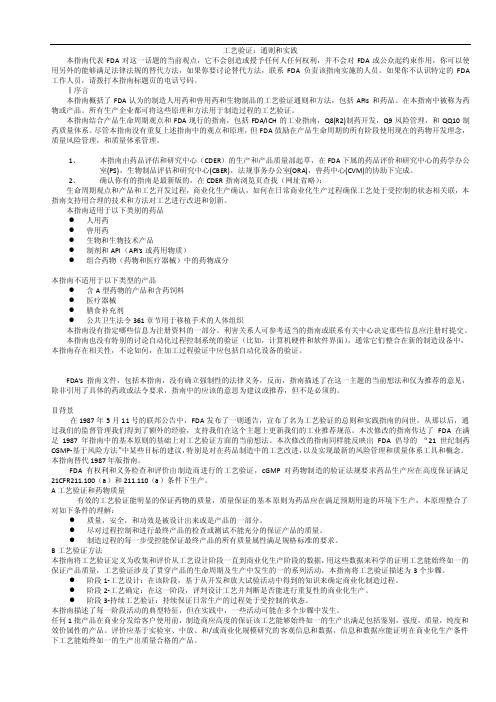
工艺验证:通则和实践本指南代表FDA对这一话题的当前观点,它不会创造或授予任何人任何权利,并不会对FDA或公众起约束作用,你可以使用另外的能够满足法律法规的替代方法,如果你要讨论替代方法,联系FDA负责该指南实施的人员。
如果你不认识特定的FDA 工作人员,请拨打本指南标题页的电话号码。
Ⅰ序言本指南概括了FDA认为的制造人用药和兽用药和生物制品的工艺验证通则和方法,包括APIs和药品。
在本指南中被称为药物或产品。
所有生产企业都可将这些原理和方法用于制造过程的工艺验证。
本指南结合产品生命周期观点和FDA现行的指南,包括FDA/ICH的工业指南,Q8(R2)制药开发,Q9风险管理,和QQ10制药质量体系。
尽管本指南没有重复上述指南中的观点和原理,但FDA鼓励在产品生命周期的所有阶段使用现在的药物开发理念,质量风险管理,和质量体系管理。
1、本指南由药品评估和研究中心(CDER)的生产和产品质量部起草,在FDA下属的药品评价和研究中心的药学办公室(PS),生物制品评估和研究中心(CBER),法规事务办公室(ORA),兽药中心(CVM)的协助下完成。
2、确认你有的指南是最新版的,在CDER指南浏览页查找(网址省略):生命周期观点和产品和工艺开发过程,商业化生产确认,如何在日常商业化生产过程确保工艺处于受控制的状态相关联,本指南支持用合理的技术和方法对工艺进行改进和创新。
本指南适用于以下类别的药品●人用药●兽用药●生物和生物技术产品●制剂和API(API’s或药用物质)●组合药物(药物和医疗器械)中的药物成分本指南不适用于以下类型的产品●含A型药物的产品和含药饲料●医疗器械●膳食补充剂●公共卫生法令361章节用于移植手术的人体组织本指南没有指定哪些信息为注册资料的一部分。
利害关系人可参考适当的指南或联系有关中心决定那些信息应注册时提交。
本指南也没有特别的讨论自动化过程控制系统的验证(比如,计算机硬件和软件界面),通常它们整合在新的制造设备中,本指南存在相关性,不论如何,在加工过程验证中应包括自动化设备的验证。
FDA-无菌药品生产指南(中英文版)介绍

U.S. Department of Health and Human Services Food and Drug Administration
Center for Drug Evaluation and Research (CDER) Center for Biologics Evaluation and Research (CBER)
B. Technical Framework.................................................................................................................... 3 技术架构
III. SCOPE ............................................................................................................................... 4 适用范围
Translated from / 译自:
Guidance for Industry
Sterile Drug Products Produced by Aseptic Processing — Current Good Manufacturing Practice
行业指南 无菌加工生产的无菌药品 —现行的生产质量管理规范(cGMP)
II. BACKGROUND ............................................................................................................... 2 背景
美国FDA分析方法验证指南中文译稿[1]
![美国FDA分析方法验证指南中文译稿[1]](https://img.taocdn.com/s3/m/fa8be4d5ddccda38366baf5b.png)
1II. 背景 (2)III. 分析方法的类型 (3)A. 法定分析方法 (3)B. 可选择分析方法 (3)3 C. 稳定性指示分析 (3)IV. 对照品……………………………………………………………………………4A. 对照品的类型 (4)B. 分析报告单 (4)C. 对照品的界定 (4)V. IND 中的分析方法验证 (6)VI. NDA, ANDA, BLA 和PLA 中分析方法验证的内容和格式 (6)A. 原则 (6)B. 取样 (7)C. 仪器和仪器参数 (7)D. 试剂 (7)E. 系统适应性实验 (7)F. 对照品的制备 (7)G. 样品的制备 (8)H. 分析方法 (8)L. 计算 (8)J. 结果报告 (8)VII. NDA,ANDA,BLA 和PLA 中的分析方法验证 (9)A.非法定分析方法 (9)1.验证项目 (9)2. 其它分析方法验证信息 (10)a. 耐用性 (11)b. 强降解实验 (11)c. 仪器输出/原始资料 (11)3.各类检测的建议验证项目 (13)B.法定分析方法 (15)VIII. 统计分析…………………………………………………………………………15A. 总则 (15)C. 统计 (16)IX. 再验证 (16)X. 分析方法验证技术包:内容和过程……………………………………………17A. 分析方法验证技术包 (17)B. 样品的选择和运输 (18)C. 各方责任 (19)XI. 方法………………………………………………………………………………20A. 高效液相色谱(HPLC) (20)B. 气相色谱(GC) (22)C. 分光光度法,光谱学,光谱法和相关的物理方法 (23)D. 毛细管电泳 (23)E. 旋光度 (24)F. 粒径相关的分析方法 (25)G. 溶出度 (26)H. 其它仪器分析方法 (27)附件A:NDA,ANDA,BLA 和PLA 申请的内容 (28)附件B:分析方法验证的问题和延误 (29)参考文献……………………………………………………………………………………30术语表………………………………………………………………………………………32This guidance provides recommendations to applicants on submitting analytical procedures, validation data, and samples to support the documentation of the identity, strength, quality, purity, and potency of drug substances and drug products.1. 绪论本指南旨在为申请者提供建议,以帮助其提交分析方法,方法验证资料和样品用于支持原料药和制剂的认定,剂量,质量,纯度和效力方面的文件。
FDA指南中文版

目录表I. 导言 (1)II. 背景 (2)III. 分析方法的类型 (3)A. 法定分析方法 (3)B. 可选择分析方法 (3)3 C. 稳定性指示分析 (3)IV. 对照品 (4)A. 对照品的类型 (4)B. 分析报告单 (4)C. 对照品的界定 (4)V. IND中的分析方法验证 (6)VI. NDA, ANDA, BLA 和PLA中分析方法验证的内容和格式 (6)A. 原则 (6)B. 取样 (7)C. 仪器和仪器参数 (7)D. 试剂 (7)E. 系统适应性实验 (7)F. 对照品的制备 (7)G. 样品的制备 (8)H. 分析方法 (8)L. 计算 (8)J. 结果报告 (8)VII. NDA,ANDA,BLA和PLA中的分析方法验证 (9)A. 非法定分析方法 (9)1.验证项目 (9)2. 其它分析方法验证信息 (10)a. 耐用性 (11)b. 强降解实验 (11)c. 仪器输出/原始资料 (11)3.各类检测的建议验证项目 (13)B. 法定分析方法 (15)VIII. 统计分析 (15)A. 总则 (15)B. 比较研究 (16)C. 统计 (16)IX. 再验证 (16)X. 分析方法验证技术包:内容和过程 (17)A. 分析方法验证技术包 (17)B. 样品的选择和运输 (18)C. 各方责任 (19)XI. 方法 (20)A. 高效液相色谱(HPLC) (20)B. 气相色谱(GC) (22)C. 分光光度法,光谱学,光谱法和相关的物理方法 (23)D. 毛细管电泳 (23)E. 旋光度 (24)F. 粒径相关的分析方法 (25)G. 溶出度 (26)H. 其它仪器分析方法 (27)附件 A:NDA,ANDA,BLA和PLA申请的内容 (28)附件 B:分析方法验证的问题和延误 (29)参考文献 (30)术语表 (32)I. INTRODUCTIONThis guidance provides recommendations to applicants on submitting analyticalprocedures, validation data, and samples to support the documentation of the identity, strength, quality, purity, and potency of drug substances and drug products.1. 绪论本指南旨在为申请者提供建议,以帮助其提交分析方法,方法验证资料和样品用于支持原料药和制剂的认定,剂量,质量,纯度和效力方面的文件。
美国FDA指南-中文版

《美国FDA认证与申办指南》权威资讯系列《合成原料药DMF起草大纲》使用说明:1、本大纲是为了帮助我公司客户把握DMF的整体内容而准备的,由于DMF内容繁多,从整体上了解内容框架和组成部分,对于理解FDA对DMF的要求和意图非常有必要;2、根据FDA的要求,凡是本大纲提到的内容,原料药制造商均应该提供。
因此,客户务必依照规定提供尽可能详细的内容。
3、本大纲的内容和相关要求能够确保客户目前的运作达到FDA的cGMP标准,因此,准备DMF的过程,也使客户按照FDA的要求进行整改和提高的过程,这些都为FDA未来的现场检查打下良好基础;4、凡是本大纲中提到的非技术性具体内容要求,请参照本公司专有的与此大纲配套的相关DFM指导性文件,包括《FDA药物主文件指南》、《关于在药品递交中递交的有关原料药生产的支持文件的指南》、《药物申办中质量管理方面通用技术文件格式与内容要求》;5、凡是本大纲中提到的技术性具体内容要求,如杂质、稳定性、验证等具体技术要求,请参照本公司专有的FDA相关技术标准文件,包括《原料药认证指南》、《制剂认证指南》、《化学药物稳定性指南》、《化学药物杂质指南》、《化学药物化验与合格参数指南》、《化学药物验证指南》等;《合成原料药DMF起草大纲》一、公司和生产场地的基本描述1、第一类的DMF文件建议由位于美国之外的人提供,以帮助FDA对他们的生产设施进行现场检查。
DMF文件应描述生产场地、设备能力、生产流程图等。
A Type I DMF is recommended for a person outside of the United States to assist FDA in conducting on site inspections of their manufacturing facilities. The DMF should describe the manufacturing site, equipment capabilities, and operational layout.2、第一类的DMF文件对美国国内设施通常不需要,除非该设施没有登记并定期接受检查。
FDA最新工艺验证指南(XXXX1版)(中文版)

Guidance for Industry 行业指南Process Validation: General Principles and Practices工艺验证:一般原则与规范U.S. Department of Health and Human ServicesFood and Drug AdministrationCenter for Drug Evaluation and Research (CDER)Center for Biologics Evaluation and Research (CBER)Center for Veterinary Medicine (CVM)January 2011Current Good Manufacturing Practices (CGMP)Revision 1美国卫生与人类服务部食品药品管理局药物评价和研究中心(CDER)生物制品评价和研究中心(CBER)兽药中心(CVM)2011年1月现行药品质量生产管理规范(CGMP)修订版1包含不具约束力的建议中文译稿:北京大学药物信息与工程研究中心info@ Guidance for Industry 行业指南Process Validation: General Principles and Practices工艺验证:一般原则与规范Additional copies are available from:Office of CommunicationsDivision of Drug Information, WO51, Room 220110903 New Hampshire Ave.Silver Spring, MD 20993Phone: 301-796-3400; Fax: 301-847-8714druginfo@/Drugs/GuidanceComplianceRegulatoryInformation/Guidances/default.htmand/orOffice of Communication, Outreach and Development, HFM-40Center for Biologics Evaluation and ResearchFood and Drug Administration1401 Rockville Pike, Rockville, MD 20852-1448(Tel) 800-835-4709 or 301-827-1800/BiologicsBloodVaccines/GuidanceComplianceRegulatoryInformation/Guidances/default.htm and/orCommunications Staff, HFV-12Center for Veterinary MedicineFood and Drug Administration7519 Standish Place,Rockville, MD 20855(Tel) 240-276-9300/AnimalVeterinary/GuidanceComplianceEnforcement/GuidanceforIndustry/default.htm包含不具约束力的建议中文译稿:北京大学药物信息与工程研究中心info@另外的副本可从以下部门得到:马里兰州银泉市新罕布什尔大道10193号2201室药品信息处,对外信息办公室,邮政编码:20993电话:301-796-3400; 传真:301-847-8714druginfo@/Drugs/GuidanceComplianceRegulatoryInformation/Guidances/default.htm和/或马里兰州洛克维尔市洛克维尔大道1401号HFM-40 FDA生物制品评价和研究中心对外信息、外联与发展办公室邮政编码:20852-1448电话:800-835-4709 或301-827-1800/BiologicsBloodVaccines/GuidanceComplianceRegulatoryInformation/Guidances/default.htm和/或马里兰州洛克维尔市Standish Place 7519号食品药品管理局兽药中心HFV-12通讯处,邮政编码:20885电话:240-276-9300/AnimalVeterinary/GuidanceComplianceEnforcement/GuidanceforIndustry/default.htmU.S. Department of Health and Human ServicesFood and Drug AdministrationCenter for Drug Evaluation and Research (CDER)Center for Biologics Evaluation and Research (CBER)Center for Veterinary Medicine (CVM)January 2011Current Good Manufacturing Practices (CGMP)Revision 1美国卫生与人类服务部食品药品管理局药物评估和研究中心(CDER)生物制品评估和研究中心(CBER)兽药中心(CVM)2011年1月现行药品质量生产管理规范(CGMP)修订版1包含不具约束力的建议中文译稿:北京大学药物信息与工程研究中心info@Table of Contents目录I. INTRODUCTION (1)一. 简介 (1)II. BACKGROUND (3)二. 背景 (3)A. Process Validation and Drug Quality (4)A. 工艺验证与药品质量 (4)B. Approach to Process Validation (5)B. 工艺验证方法 (5)III. STATUTORY AND REGULATORY REQUIREMENTS FOR PROCESS VALIDATION (7)三. 对工艺验证的法规和监管要求 (7)IV. RECOMMENDATIONS (9)四. 建议 (9)A. General Considerations for Process Validation (9)A. 对工艺验证的总体考虑 (9)B. Stage 1 - Process Design (10)B. 第一阶段- 工艺设计 (10)1. Building and Capturing Process Knowledge and Understanding (11)1. 建立和捕获工艺知识与理解 (11)2. Establishing a Strategy for Process Control (12)2. 建立工艺控制策略 (12)C. Stage 2 - Process Qualification (14)C. 第二阶段- 工艺确认 (14)1. Design of a Facility and Qualification of Utilities and Equipment (14)1. 厂房设施设计以及公用设施与设备确认 (14)2. Process Performance Qualification (16)2. 工艺性能确认 (16)3. PPQ Protocol (17)3. 工艺性能确认方案 (17)4. PPQ Protocol Execution and Report (19)4. 工艺性能确认执行与报告 (19)D. Stage 3 - Continued Process Verification (20)D. 第三阶段- 持续工艺验证 (20)V. CONCURRENT RELEASE OF PPQ BATCHES (22)五. 工艺性能确认批次的同时放行 (22)VI. DOCUMENTATION (24)六. 文件记录 (24)VII. ANALYTICAL METHODOLOGY (24)七. 分析方法 (24)GLOSSARY (26)术语表 (26)REFERENCES (28)参考资料 (28)包含不具约束力的建议中文译稿:北京大学药物信息与工程研究中心info@1Guidance for Industry1行业指南1Process Validation: General Principles and Practices工艺验证:一般原则与实施This guidance represents the Food and Drug Administration’s (FDA’s) current thinking on this topic. It does not create or confer any rights for or on any person and does not operate to bind FDA or the public. You canuse an alternative approach if the approach satisfies the requirements of the applicable statutes andregulations. If you want to discuss an alternative approach, contact the FDA staff responsible forimplementing this guidance. If you cannot identify the appropriate FDA staff, call the appropriate numberlisted on the title page of this guidance.本指南体现了食品药品管理局(FDA)关于这一主题的最新见解。
美国FDA分析方法验证指南中文译稿
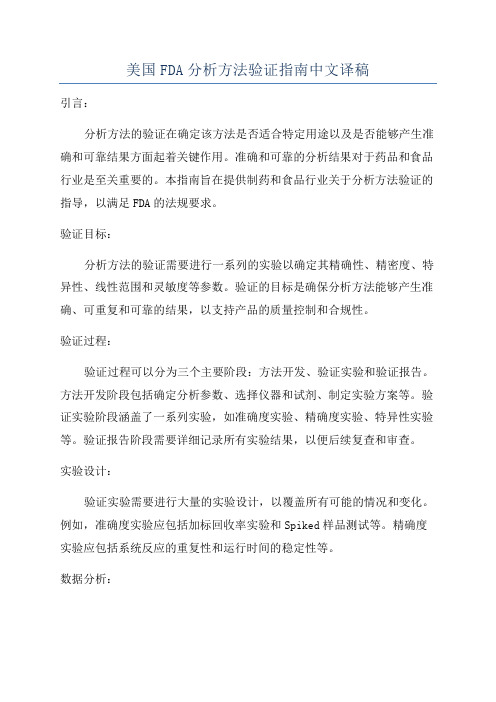
美国FDA分析方法验证指南中文译稿引言:分析方法的验证在确定该方法是否适合特定用途以及是否能够产生准确和可靠结果方面起着关键作用。
准确和可靠的分析结果对于药品和食品行业是至关重要的。
本指南旨在提供制药和食品行业关于分析方法验证的指导,以满足FDA的法规要求。
验证目标:分析方法的验证需要进行一系列的实验以确定其精确性、精密度、特异性、线性范围和灵敏度等参数。
验证的目标是确保分析方法能够产生准确、可重复和可靠的结果,以支持产品的质量控制和合规性。
验证过程:验证过程可以分为三个主要阶段:方法开发、验证实验和验证报告。
方法开发阶段包括确定分析参数、选择仪器和试剂、制定实验方案等。
验证实验阶段涵盖了一系列实验,如准确度实验、精确度实验、特异性实验等。
验证报告阶段需要详细记录所有实验结果,以便后续复查和审查。
实验设计:验证实验需要进行大量的实验设计,以覆盖所有可能的情况和变化。
例如,准确度实验应包括加标回收率实验和Spiked样品测试等。
精确度实验应包括系统反应的重复性和运行时间的稳定性等。
数据分析:验证实验收集到的数据需要进行统计分析,以确定分析方法的可信度。
数据分析应包括数学计算、图表绘制和合规性评估等。
分析结果应该足够准确和可靠,以支持产品的质量控制和合规性。
验证报告:验证报告是验证过程的最终产物,它需要详细记录实验设计、数据分析和结论等信息。
验证报告应包括验证实验的目的、方法、结果和结论等内容。
验证报告需要通过内部审查和外部审查,确保其准确性和可靠性。
结论:美国FDA的《分析方法验证指南》为制药和食品行业提供了详细的指导,以确保分析方法的有效性和可靠性。
通过正确进行方法的验证,可以保证分析结果的准确性,从而支持产品的质量控制和合规性。
制药和食品企业应密切遵循该指南,以便符合FDA的法规要求。
美国FDA分析方法验证指南中英文对照--6

美国FDA分析⽅法验证指南中英⽂对照--6XI. METHODOLOGYSections II through IX provide general information on the submission of analytical procedures and methods validation information, including validation characteristics. Additional information on certain methodologies is provided below.XI.⽅法学II章到第IX章提供了分析⽅法和分析⽅法验证资料⽅⾯的基本信息,包括验证项⽬。
下⽂就⼀些具体的⽅法给出了说明:A. High-Pressure Liquid Chromatography (HPLC)The widespread use of HPLC analytical procedures and the multitude of commercial sources of columns and packings frequently have created problems in assessing comparability. Many of the following points may also apply to other chromatographic analytical procedures.⾊谱(HPLC)⾼效液相⾊谱A.⾼效液相HPLC分析⽅法的⼴泛应⽤及⾊谱柱和柱填充的众多来源都经常会给可⽐性评估带来很多问题。
如下这些要点中,很多都适⽤于其它⾊谱分析⽅法。
1. ColumnThe following characteristics are useful for defining a particular column and, if known, should be included in the analytical procedure description. If method development has indicated that columns from only one commercial source are suitable, this information should be included as part of the analytical procedure. If more than one column is suitable, a listing of columns found to be equivalent should be included.1.⾊谱柱在定义某⼀⾊谱柱时,如下这些性质是很有⽤的,也应当要包括在分析⽅法描述中。
FDA仿制药一致性评价指导指南(中英文版)

Guidance for Industry Controlled Correspondence Related to Generic DrugDevelopment行业指南:有关仿制药研发的书面咨询This guidance represents the current thinking of the Food and Drug Administration (FDA, or the Agency) on this topic. It does not establish any rights for any person and is not binding on FDA or the public. You can use an alternative approach if it satisfies the requirements of the applicable statutes and regulations. To discuss an alternative approach, contact the FDA staff responsible for this guidance as listed on the title page.该指南代表了FDA对该主题目前的看法。
它并不会赋予任何人任何权利,也不会约束FDA或公众,如果有替代的方法能够满足法律法规的要求,可以使用替代的方法。
如果想探讨替代的方法,请联系该指南首页中FDA 负责执行该指南的工作人员。
I.INTRODUCTION 简介This guidance provides information regarding the process by which generic drug manufacturers and related industry can submit correspondence to FDA requesting information related to generic drug development. This guidance also describes the Agency’s process for providing communications related to such correspondence. FDA is issuing this guidance as part of its implementation of the Generic Drug User Fee Amendments of 2012 (Public Law 112-144, Title III), commonly referred to as GDUFA.该指南描述了仿制药生产商以及相关行业向FDA提交书面咨询,询问有关仿制药研发信息的过程,同时还描述了FDA针对这些书面咨询提供交流的过程。
FDA 行业指南 中英对照 待完成
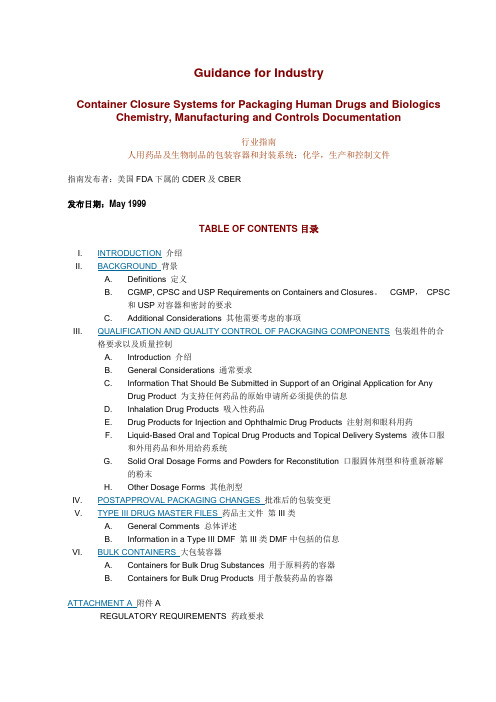
Guidance for IndustryContainer Closure Systems for Packaging Human Drugs and Biologics Chemistry, Manufacturing and Controls Documentation行业指南人用药品及生物制品的包装容器和封装系统:化学,生产和控制文件指南发布者:美国FDA下属的CDER及CBER发布日期:May 1999TABLE OF CONTENTS目录I. INTRODUCTION介绍II. BACKGROUND 背景A. Definitions 定义B. CGMP, CPSC and USP Requirements on Containers and Closures。
CGMP,CPSC和USP对容器和密封的要求C. Additional Considerations 其他需要考虑的事项III. QUALIFICATION AND QUALITY CONTROL OF PACKAGING COMPONENTS包装组件的合格要求以及质量控制A. Introduction 介绍B. General Considerations 通常要求C. Information That Should Be Submitted in Support of an Original Application for AnyDrug Product 为支持任何药品的原始申请所必须提供的信息D. Inhalation Drug Products 吸入性药品E. Drug Products for Injection and Ophthalmic Drug Products 注射剂和眼科用药F. Liquid-Based Oral and Topical Drug Products and Topical Delivery Systems 液体口服和外用药品和外用给药系统G. Solid Oral Dosage Forms and Powders for Reconstitution 口服固体剂型和待重新溶解的粉末H. Other Dosage Forms 其他剂型IV. POSTAPPROVAL PACKAGING CHANGES 批准后的包装变更V. TYPE III DRUG MASTER FILES 药品主文件第III类A. General Comments 总体评述B. Information in a Type III DMF 第III类DMF中包括的信息VI. BULK CONTAINERS 大包装容器A. Containers for Bulk Drug Substances 用于原料药的容器B. Containers for Bulk Drug Products 用于散装药品的容器ATTACHMENT A 附件AREGULATORY REQUIREMENTS 药政要求ATTACHMENT B 附件BCOMPLIANCE POLICY GUIDES THAT CONCERN PACKAGING 关于包装,所适用的政策指南ATTACHMENT C 附件CEXTRACTION STUDIES “提取性"研究ATTACHMENT D 附件DABBREVIATIONS 缩略语ATTACHMENT E 附件EREFERENCES 参考文献GUIDANCE FOR INDUSTRY1Container Closure Systems for Packaging Human Drugs and Biologics Chemistry, Manufacturing and Controls DocumentationI.INTRODUCTION介绍This document is intended to provide guidance on general principles2 for submitting information on packaging materials used for human drugs and biologics。
FDA行业指南中英对照待完成
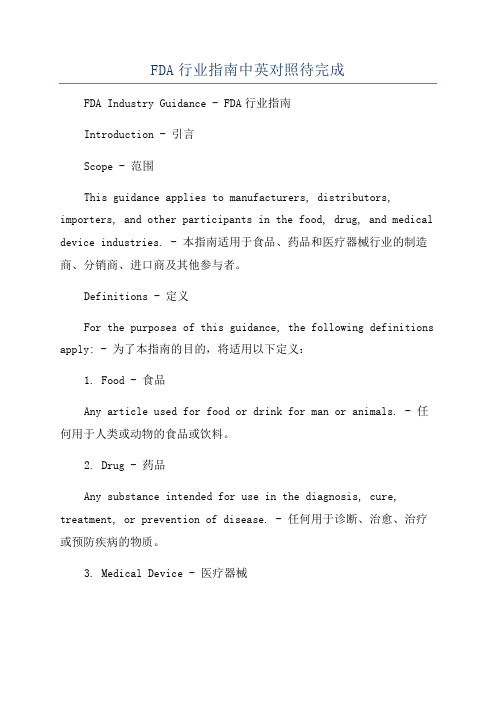
FDA行业指南中英对照待完成FDA Industry Guidance - FDA行业指南Introduction - 引言Scope - 范围This guidance applies to manufacturers, distributors, importers, and other participants in the food, drug, and medical device industries. - 本指南适用于食品、药品和医疗器械行业的制造商、分销商、进口商及其他参与者。
Definitions - 定义For the purposes of this guidance, the following definitions apply: - 为了本指南的目的,将适用以下定义:1. Food - 食品Any article used for food or drink for man or animals. - 任何用于人类或动物的食品或饮料。
2. Drug - 药品Any substance intended for use in the diagnosis, cure, treatment, or prevention of disease. - 任何用于诊断、治愈、治疗或预防疾病的物质。
3. Medical Device - 医疗器械Any instrument, apparatus, or device intended for use in the diagnosis, cure, mitigation, treatment, or prevention of disease. - 任何用于诊断、治愈、缓解、治疗或预防疾病的仪器、装置或设备。
4. Manufacturer - 制造商Product Quality Requirements - 产品质量要求Manufacturers should ensure that products meet the appropriate quality standards established by the FDA. - 制造商应确保产品符合FDA制定的适当质量标准。
FDA指南草案(中文)
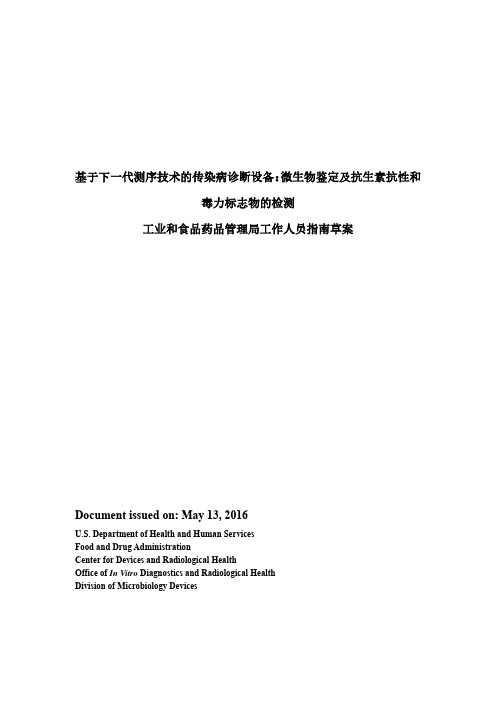
基于下一代测序技术的传染病诊断设备:微生物鉴定及抗生素抗性和毒力标志物的检测工业和食品药品管理局工作人员指南草案Document issued on: May 13, 2016U.S. Department of Health and Human ServicesFood and Drug AdministrationCenter for Devices and Radiological HealthOffice of In Vitro Diagnostics and Radiological HealthDivision of Microbiology Devices目录I.简介 (1)II.背景 (1)A.传染病NGS Dx设备的系统方法 (2)B.FDA-ARGOS: FDA监管级微生物序列数据库 (2)III.范围 (3)IV.利弊分析 (5)V.设备描述 (5)A.预期用途 (5)B.测试方法学 (6)C.辅助试剂 (7)D.控制 (8)(1)阴性对照 (8)(2)阳性对照 (9)(3)内部对照 (9)E.试验结果和报告的解释 (10)VI.设备验证 (10)A.预分析因素 (11)(1)样本收集和处理 (11)(2)样本准备和测序 (12)(3)测序、化学过程和数据收集 (12)(4)数据储存 (13)(5)临床决策要求 (13)B.感染性疾病NGS Dx设备性能指标 (13)(1)感染性疾病NGS Dx设备数据集 (14)(2)测序策略 (14)(3)用于靶向鉴定的参考序列和所选的靶标 (14)(4)临床识别信息学工序流程 (15)(5)减法原理 (15)(6)质量控制 (15)(7)测序及序列比对 (15)(8)污染分析 (15)(9)感染性疾病NGS Dx设备应当提供从样本到结果的周期 (16)(10)数据存储 (16)C.分析性能 (17)(1)检测极限 (17)(2)包容性 (17)(3)干扰物质 (18)(4)精确(可重现性及可重复性) (19)(5)携带及交叉污染 (19)(6)稳定性 (19)(7)其他分析性实验 (19)D.仪器和软件 (19)E.临床评估 (21)(1)阴性百分比一致性评价 (21)(2)阳性百分比一致性评价 (22)(3)数据展示 (23)(4)样本研究和样本类型 (23)Ⅶ设备调试 (24)基于下一代测序技术的传染病诊断设备:微生物鉴定及抗生素抗性和毒力标志物的检测工业和食品药品管理局工作人员指南草案I.简介美国食品药品监督管理局(FDA)发布该指南草案是为工业和机构工作人员提供建议,以研究建立基于下一代测序的用于分析传染病临床表现特征的微生物鉴定及抗生素耐药性和毒力标志的检测设备(以下简称“传染病NGS Dx设备”)。
美国FDA分析方法验证指南中英文对照
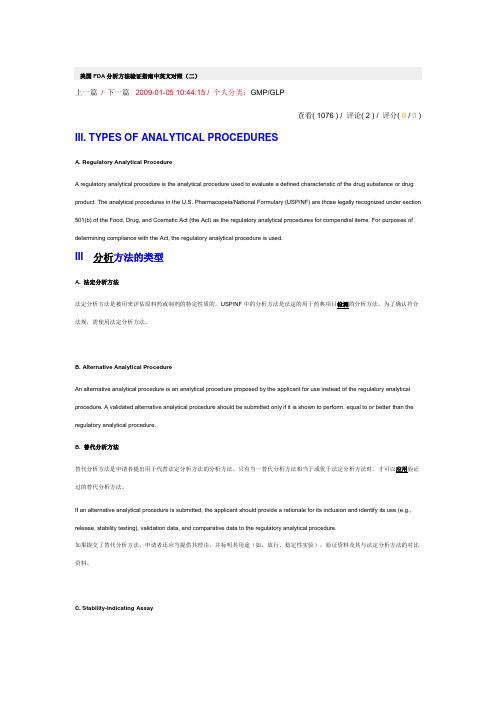
美国FDA分析方法验证指南中英文对照(二)上一篇/ 下一篇 2009-01-05 10:44:15 / 个人分类:GMP/GLP查看( 1076 ) / 评论( 2 ) / 评分( 0 / 0 ) III. TYPES OF ANALYTICAL PROCEDURESA. Regulatory A nalytical ProcedureA regulatory analy tical procedure is the analy tical procedure used to ev aluate a def ined characteristic of the drug substance or drug product. The analy tical procedures in the U.S. Pharmacopeia/National Formulary (USP/NF) are those legally recognized under section 501(b) of the Food, Drug, and Cosmetic Act (the Act) as the regulatory analytical procedures f or compendial items. For purpos es of determining compliance with the Act, the regulatory analytical procedure is used.III分析方法的类型A. 法定分析方法法定分析方法是被用来评估原料药或制剂的特定性质的。
USP/NF中的分析方法是法定的用于药典项目检测的分析方法。
为了确认符合法规,需使用法定分析方法。
B. A lternative A nalytical ProcedureAn alternativ e analy tical procedure is an analytical procedure proposed by the applicant f or use instead of the regulatory analy tical procedure. A v alidated alternativ e analy tical procedure should be submitted only if it is shown to perf orm. equal to or better than the regulatory analy tical procedure.B. 替代分析方法替代分析方法是申请者提出用于代替法定分析方法的分析方法。
FDA最新工艺验证指南(2011.1版)(中文版)
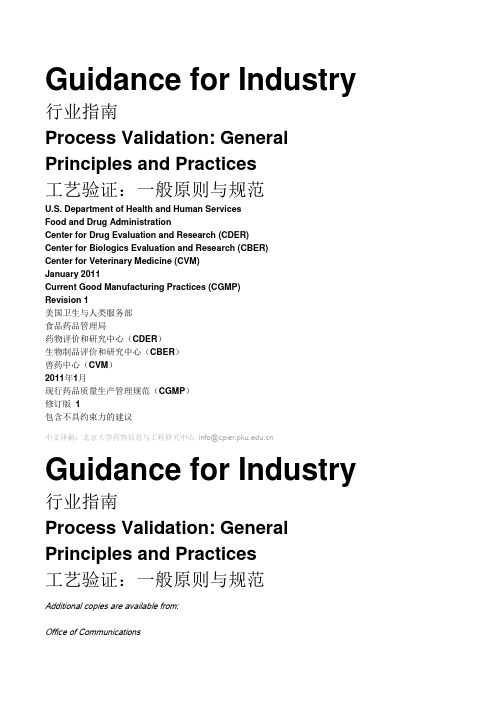
Guidance for Industry 行业指南Process Validation: General Principles and Practices工艺验证:一般原则与规范U.S. Department of Health and Human ServicesFood and Drug AdministrationCenter for Drug Evaluation and Research (CDER)Center for Biologics Evaluation and Research (CBER)Center for Veterinary Medicine (CVM)January 2011Current Good Manufacturing Practices (CGMP)Revision 1美国卫生与人类服务部食品药品管理局药物评价和研究中心(CDER)生物制品评价和研究中心(CBER)兽药中心(CVM)2011年1月现行药品质量生产管理规范(CGMP)修订版1包含不具约束力的建议中文译稿:北京大学药物信息与工程研究中心************** Guidance for Industry 行业指南Process Validation: General Principles and Practices工艺验证:一般原则与规范Additional copies are available from:Office of CommunicationsDivision of Drug Information, WO51, Room 220110903 New Hampshire Ave.Silver Spring, MD 20993Phone: 301-796-3400; Fax: 301-847-8714****************.gov/Drugs/GuidanceComplianceRegulatoryInformation/Guidances/default.htmand/orOffice of Communication, Outreach and Development, HFM-40Center for Biologics Evaluation and ResearchFood and Drug Administration1401 Rockville Pike, Rockville, MD 20852-1448(Tel) 800-835-4709 or 301-827-1800/BiologicsBloodVaccines/GuidanceComplianceRegulatoryInformation/Guidances/default.htm and/orCommunications Staff, HFV-12Center for Veterinary MedicineFood and Drug Administration7519 Standish Place,Rockville, MD 20855(Tel) 240-276-9300/AnimalVeterinary/GuidanceComplianceEnforcement/GuidanceforIndustry/default.htm包含不具约束力的建议中文译稿:北京大学药物信息与工程研究中心**************另外的副本可从以下部门得到:马里兰州银泉市新罕布什尔大道10193号2201室药品信息处,对外信息办公室,邮政编码:20993电话:301-796-3400; 传真:301-847-8714****************.gov/Drugs/GuidanceComplianceRegulatoryInformation/Guidances/default.htm和/或马里兰州洛克维尔市洛克维尔大道1401号HFM-40 FDA生物制品评价和研究中心对外信息、外联与发展办公室邮政编码:20852-1448电话:800-835-4709 或301-827-1800/BiologicsBloodVaccines/GuidanceComplianceRegulatoryInformation/Guidances/default.htm和/或马里兰州洛克维尔市Standish Place 7519号食品药品管理局兽药中心HFV-12通讯处,邮政编码:20885电话:240-276-9300/AnimalVeterinary/GuidanceComplianceEnforcement/GuidanceforIndustry/default.htmU.S. Department of Health and Human ServicesFood and Drug AdministrationCenter for Drug Evaluation and Research (CDER)Center for Biologics Evaluation and Research (CBER)Center for Veterinary Medicine (CVM)January 2011Current Good Manufacturing Practices (CGMP)Revision 1美国卫生与人类服务部食品药品管理局药物评估和研究中心(CDER)生物制品评估和研究中心(CBER)兽药中心(CVM)2011年1月现行药品质量生产管理规范(CGMP)修订版 1包含不具约束力的建议中文译稿:北京大学药物信息与工程研究中心**************Table of Contents目录I. INTRODUCTION (1)一. 简介 (1)II. BACKGROUND (3)二. 背景 (3)A. Process Validation and Drug Quality (4)A. 工艺验证与药品质量 (4)B. Approach to Process Validation (5)B. 工艺验证方法 (5)III. STATUTORY AND REGULATORY REQUIREMENTS FOR PROCESS VALIDATION (7)三. 对工艺验证的法规和监管要求 (7)IV. RECOMMENDATIONS (9)四. 建议 (9)A. General Considerations for Process Validation (9)A. 对工艺验证的总体考虑 (9)B. Stage 1 - Process Design (10)B. 第一阶段- 工艺设计 (10)1. Building and Capturing Process Knowledge and Understanding (11)1. 建立和捕获工艺知识与理解 (11)2. Establishing a Strategy for Process Control (12)2. 建立工艺控制策略 (12)C. Stage 2 - Process Qualification (14)C. 第二阶段- 工艺确认 (14)1. Design of a Facility and Qualification of Utilities and Equipment (14)1. 厂房设施设计以及公用设施与设备确认 (14)2. Process Performance Qualification (16)2. 工艺性能确认 (16)3. PPQ Protocol (17)3. 工艺性能确认方案 (17)4. PPQ Protocol Execution and Report (19)4. 工艺性能确认执行与报告 (19)D. Stage 3 - Continued Process Verification (20)D. 第三阶段- 持续工艺验证 (20)V. CONCURRENT RELEASE OF PPQ BATCHES (22)五. 工艺性能确认批次的同时放行 (22)VI. DOCUMENTATION (24)六. 文件记录 (24)VII. ANALYTICAL METHODOLOGY (24)七. 分析方法 (24)GLOSSARY (26)术语表 (26)REFERENCES (28)参考资料 (28)包含不具约束力的建议中文译稿:北京大学药物信息与工程研究中心**************1Guidance for Industry1行业指南1Process Validation: General Principles and Practices工艺验证:一般原则与实施This guidance represents the Food and Drug Administration’s (FDA’s) current thin king on this topic. It does not create or confer any rights for or on any person and does not operate to bind FDA or the public. You can use an alternative approach if the approach satisfies the requirements of the applicable statutes and regulations. If you want to discuss an alternative approach, contact the FDA staff responsible for implementing this guidance. If you cannot identify the appropriate FDA staff, call the appropriate number listed on the title page of this guidance.本指南体现了食品药品管理局(FDA)关于这一主题的最新见解。
FDA工艺验证指南(2023年.1版)(中文版)
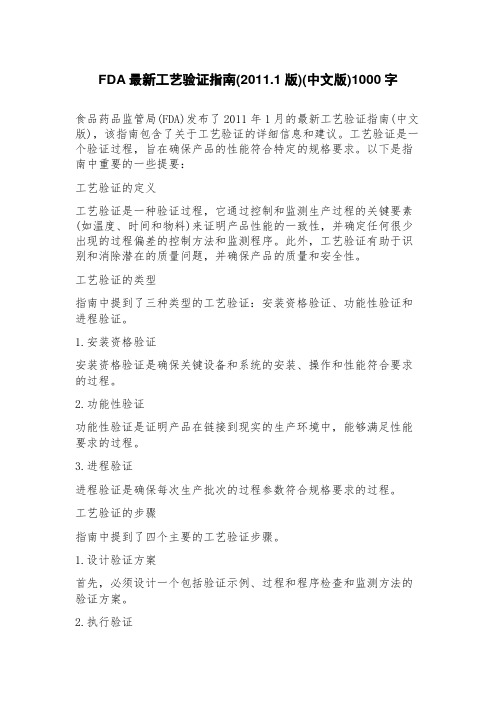
FDA最新工艺验证指南(2011.1版)(中文版)1000字食品药品监管局(FDA)发布了2011年1月的最新工艺验证指南(中文版),该指南包含了关于工艺验证的详细信息和建议。
工艺验证是一个验证过程,旨在确保产品的性能符合特定的规格要求。
以下是指南中重要的一些提要:工艺验证的定义工艺验证是一种验证过程,它通过控制和监测生产过程的关键要素(如温度、时间和物料)来证明产品性能的一致性,并确定任何很少出现的过程偏差的控制方法和监测程序。
此外,工艺验证有助于识别和消除潜在的质量问题,并确保产品的质量和安全性。
工艺验证的类型指南中提到了三种类型的工艺验证:安装资格验证、功能性验证和进程验证。
1.安装资格验证安装资格验证是确保关键设备和系统的安装、操作和性能符合要求的过程。
2.功能性验证功能性验证是证明产品在链接到现实的生产环境中,能够满足性能要求的过程。
3.进程验证进程验证是确保每次生产批次的过程参数符合规格要求的过程。
工艺验证的步骤指南中提到了四个主要的工艺验证步骤。
1.设计验证方案首先,必须设计一个包括验证示例、过程和程序检查和监测方法的验证方案。
2.执行验证执行验证时必须记录和监测所有的步骤和数据,特别是关键参数。
3.收集和分析数据通过收集和分析数据以确认生产过程的稳定性和一致性。
4.确定验证完成和维护验证状态一旦数据收集和分析完成,并验证的结果可以证明产品的一致性,就可以确定验证工作已经完成。
验证后,工厂必须确保维护验证状态,并定期进行监测。
总之,食品药品监管局(FDA)最新工艺验证指南(2011.1版)(中文版)提供了在生产过程中进行工艺验证的详细说明,这有助于确保生产的产品质量达到极高的水平,同时也有利于确保产品的安全性。
美国FDA药物分析程序及方法验证指导原则(中文版)
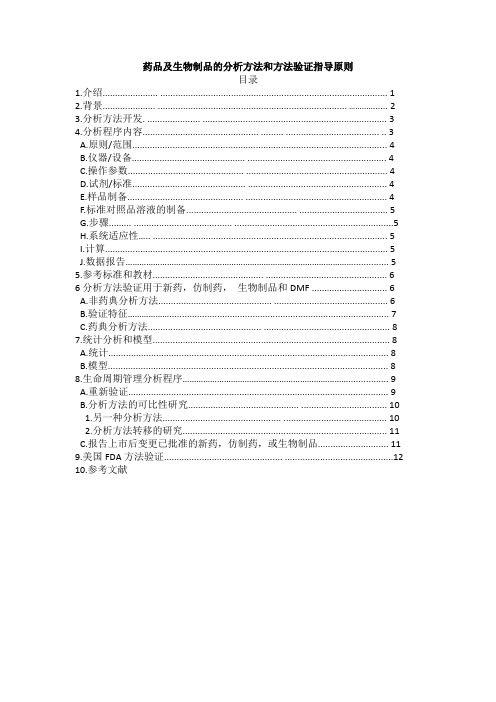
药品及生物制品的分析方法和方法验证指导原则目录1.介绍...................... (1)2.背景..................... .. (2)3.分析方法开发. ..................... . (3)4.分析程序内容.............................................. ......... ..................................... .. 3A.原则/范围 (4)B.仪器/设备............................................. . (4)C.操作参数.............................................. .. (4)D.试剂/标准............................................. . (4)E.样品制备.............................................. .. (4)F.标准对照品溶液的制备............................................ .. (5)G.步骤......... ....................................... (5)H.系统适应性..... (5)I.计算 (5)J.数据报告 (5)5.参考标准和教材............................................ (6)6分析方法验证用于新药,仿制药,生物制品和DMF (6)A.非药典分析方法............................................. (6)B.验证特征 (7)C.药典分析方法............................................. .. (8)7.统计分析和模型 (8)A.统计 (8)B.模型 (8)8.生命周期管理分析程序 (9)A.重新验证 (9)B.分析方法的可比性研究............................................ . (10)1.另一种分析方法............................................... .. (10)2.分析方法转移的研究 (11)C.报告上市后变更已批准的新药,仿制药,或生物制品 (11)9.美国FDA方法验证............................................... . (12)10.参考文献前言本指导原则草案,定稿后,将代表美国食品和药物管理局(FDA)目前关于这个话题目前的想法。
FDA无菌生产指南-中英文对照版
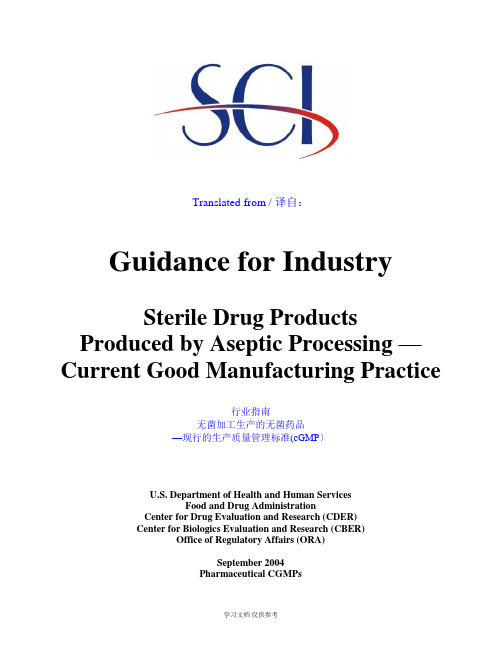
Translated from / 译自:Guidance for IndustrySterile Drug Products Produced by Aseptic Processing —Current Good Manufacturing Practice行业指南无菌加工生产的无菌药品—现行的生产质量管理标准(cGMP〕U.S. Department of Health and Human ServicesFood and Drug AdministrationCenter for Drug Evaluation and Research (CDER)Center for Biologics Evaluation and Research (CBER)Office of Regulatory Affairs (ORA)September 2004Pharmaceutical CGMPsGuidance for Industry Sterile Drug Products Produced by Aseptic Processing —Current Good Manufacturing PracticeAdditional copies are available from:Office of Training and CommunicationDivision of Drug Information, HFD-240Center for Drug Evaluation and ResearchFood and Drug Administration5600 Fishers LaneRockville, MD 20857(Tel) 301-827-4573orOffice of Communication, Training andManufacturers Assistance, HFM-40Center for Biologics Evaluation and ResearchFood and Drug Administration1401 Rockville Pike, Rockville, MD 20852-1448(Tel) Voice Information System at 800-835-4709 or 301-827-1800U.S. Department of Health and Human ServicesFood and Drug AdministrationCenter for Drug Evaluation and Research (CDER)Center for Biologics Evaluation and Research (CBER)Office of Regulatory affairs (ORA)September 2004Pharmaceutical CGMPsTABLE OF CONTENTSI.INTRODUCTION (1)简介II.BACKGROUND (2)背景A.Regulatory Framework (2)法规架构B.Technical Framework (3)技术架构III.SCOPE (4)适用范围IV.BUILDINGS AND FACILITIES (6)厂房和建筑A.Critical Area – Class 100 (ISO 5) (8)关键区域– 100级 (ISO 5)B. Supporting Clean Areas (10)辅助洁净区域C. Clean Area Separation (11)净化区的隔离D.Air Filtration (12)空气过滤1.Membrane (12)膜过滤2.High-Efficiency Particulate Air (HEPA) (13)高效颗粒空气过滤器(HEPA)E.Design (16)设计V.PERSONNEL TRAINING, QUALIFICATION, & MONITORING (20)人员的培训,资格认定和监控A.Personnel (21)人员boratory Personnel (24)实验室人员C.Monitoring Program (25)监控程序VI. COMPONENTS AND CONTAINER/CLOSURES (26)药品成分和容器/密封A. Components (26)药品成分B. Containers/Closures (29)容器/密封1.Preparation (29)准备2. Inspection of Container Closure System (31)容器密封系统的检查VII. ENDOTOXIN CONTROL (33)内毒素控制VIII. TIME LIMITATIONS (35)时间限制IX.VALIDATION OF ASEPTIC PROCESSING AND STERILIZATION (36)无菌加工和灭菌的验证A. Process Simulations (36)工艺模拟1. Study Design (37)研究设计2.Frequency and Number of Runs (39)运行频率和次数3.Duration of Runs (40)运行时间4.Size of Runs (41)批量5.Line Speed (41)运行速度6.Environmental Conditions (42)环境质量7. Media (42)培养基8.Incubation and Examination of Media-Filled Units (43)培养基灌装单位的培养和检查9.Interpretation of Test Results (45)试验结果解释B. Filtration Efficacy (47)过滤成效C. Sterilization of Equipment, Containers, and Closures (50)设备、容器和密封的灭菌1.Qualification and Validation (51)确认和验证2.Equipment Controls and Instrument Calibration (53)设备控制和仪器校准BORATORY CONTROLS (55)实验室控制A. Environmental Monitoring (56)环境监测1. General Written Program (57)书面程序2.Establishing Levels and a Trending Program (58)建立监测标准和趋势分析程序3.Disinfection Efficacy (59)消毒成效4. Monitoring Methods (60)监测方法B. Microbiological Media and Identification (62)微生物培养基及微生物的鉴定C. Prefiltration Bioburden (63)过滤前的生物负荷D. Alternate Microbiological Test Methods (63)可替代的微生物测试方法E. Particle Monitoring (63)颗粒监测XI.STERILITY TESTING (65)无菌试验A. Microbiological Laboratory Controls (67)微生物实验室控制B. Sampling and Incubation (67)取样和培养C. Investigation of Sterility Positives (68)无菌试验阳性结果的调查XII.BATCH RECORD REVIEW: PROCESS CONTROL DOCUMENTATION (73)批生产纪录工艺控制文件化APPENDIX 1: ASEPTIC PROCESSING ISOLATORS (75)附录 1: 无菌隔离装置APPENDIX 2: BLOW-FILL- SEAL TECHNOLOGY (82)附录2:吹-灌-封技术APPENDIX 3: PROCESSING PRIOR TO FILLING AND SEALING OPERATIONS (86)附录3:灌装和密封前的工艺REFERENCES (89)参考文献RELEVANT GUIDANCE DOCUMENTS (90)相关指南文件GLOSSARY (91)术语表Guidance for Industry1Sterile Drug Products Produced byAseptic Processing — Current Good Manufacturing PracticeI.INTRODUCTION简介This guidance is intended to help manufacturers meet the requirements in the Agency's current good manufacturing practice (CGMP) regulations (2l CFR parts 210 and 211) when manufacturing sterile drug and biological products using aseptic processing. This guidance replaces the 1987 Industry Guideline on Sterile Drug Products Produced by Aseptic Processing (Aseptic Processing Guideline). This revision updates and clarifies the 1987 guidance.本指南旨在帮助生产商在应用无菌工艺制造无菌药品和生物制剂时,到达FDA cGMP规章(美国联邦法规的第210及第211节)要求。
FDA外用制剂检查指南中英文版

GUIDE TO INSPECTIONS OF TOPICAL DRUG PRODUCTS局部外用药物检查指南Note: This document is reference material for investigators and other FDA personnel. The document does not bind(进退两难) FDA, and does no confer(赠予) any rights,privileges (特权), benefits(权益), or immunities(豁免) for or on any person(s).注:该指南是FDA 检查官和其他工作人员的参考材料。
该指南不是约束FDA,但也不赋予任何人特权,利益或豁免的权利。
I. PURPOSE(目的)The purpose of this guide is to provide field investigators, who arefamiliar with the provisions(食品) of the Current Good Manufacturing Practice (CGMP) regulations for pharmaceuticals, with guidance on inspecting selected facets(方面) of topical(局部的) drug product production. The subjects covered in the guide are generally applicable to all forms of topical drug products, including those that are intended to be sterile(无菌的). However, this guide does not address(介绍) every problem area that the investigator may encounter(碰见), nor every policy that pertains to(附属)topical drug products.该指南的目的是向熟悉食品CGMP规程的检察官提供药品CGMP的指导,提供局部外用药物检查方面的指南。
- 1、下载文档前请自行甄别文档内容的完整性,平台不提供额外的编辑、内容补充、找答案等附加服务。
- 2、"仅部分预览"的文档,不可在线预览部分如存在完整性等问题,可反馈申请退款(可完整预览的文档不适用该条件!)。
- 3、如文档侵犯您的权益,请联系客服反馈,我们会尽快为您处理(人工客服工作时间:9:00-18:30)。
《美国FDA认证与申办指南》权威资讯系列《合成原料药DMF起草大纲》使用说明:1、本大纲是为了帮助我公司客户把握DMF的整体内容而准备的,由于DMF内容繁多,从整体上了解内容框架和组成部分,对于理解FDA对DMF的要求和意图非常有必要;2、根据FDA的要求,凡是本大纲提到的内容,原料药制造商均应该提供。
因此,客户务必依照规定提供尽可能详细的内容。
3、本大纲的内容和相关要求能够确保客户目前的运作达到FDA的cGMP标准,因此,准备DMF的过程,也使客户按照FDA的要求进行整改和提高的过程,这些都为FDA未来的现场检查打下良好基础;4、凡是本大纲中提到的非技术性具体内容要求,请参照本公司专有的与此大纲配套的相关DFM指导性文件,包括《FDA药物主文件指南》、《关于在药品递交中递交的有关原料药生产的支持文件的指南》、《药物申办中质量管理方面通用技术文件格式与内容要求》;5、凡是本大纲中提到的技术性具体内容要求,如杂质、稳定性、验证等具体技术要求,请参照本公司专有的FDA相关技术标准文件,包括《原料药认证指南》、《制剂认证指南》、《化学药物稳定性指南》、《化学药物杂质指南》、《化学药物化验与合格参数指南》、《化学药物验证指南》等;《合成原料药DMF起草大纲》一、公司和生产场地的基本描述1、第一类的DMF文件建议由位于美国之外的人提供,以帮助FDA对他们的生产设施进行现场检查。
DMF文件应描述生产场地、设备能力、生产流程图等。
A Type I DMF is recommended for a person outside of the United States to assist FDA in conducting on site inspections of their manufacturing facilities. The DMF should describe the manufacturing site, equipment capabilities, and operational layout.2、第一类的DMF文件对美国国内设施通常不需要,除非该设施没有登记并定期接受检查。
A Type I DMF is normally not needed to describe domestic facilities, except in special cases, such as when a person is not registered and not routinely inspected.3、场地的描述应包括面积、实际地址以及表明该场地与最近的城市的距离的地图。
提供该场地的鸟瞰图和平面图。
The description of the site should include acreage, actual site address, and a map showing its location with respect to the nearest city. An aerial photograph and a diagram of the site may be helpful.4、主要生产和加工区域的平面图对于理解整个生产布局会有帮助。
应当描述主要设备的生产能力、用途和位置。
通常不用描述设备的制造商和型号,除非特别新或独特的设备。
A diagram of major production and processing areas is helpful for understanding the operational layout. Major equipment should be described in terms of capabilities, application, and location. Make and model would not normally be needed unless the equipment is new or unique.5、公司主要的组成部门结构图,包括总公司和生产场地的关键生产、质量控制、质量保证岗位,A diagram of major corporate organizational elements, with key manufacturing, quality control, and quality assurance positions highlighted, at both the manufacturing site and corporate headquarters, is also helpful.二、原料药的物理和化学特征1、特性Properties相关法规要求对原料药的物理和化学特征做出详细描述。
该要求可以通过提供下述信息来满足:名称(通用名、化学名、编码等)、化学摘要服务(CAS)编码、性状描述(如:外观、颜色、物理状态)、分子式和分子重量、结构式(包括离子状态)、立体化学(找出手性中心、顺式反式异性等)、对映结构体比率(如:外消旋物、规定的异构体、对映异构物和固态形式的混合物)、溶解度概况(水溶性的或非水溶性的)、分配系数、溶液pH值、解离常数、熔点或沸点、折射率、比重。
对于蛋白质原料药,参见:“CRC生物化学和分子生物学手册”“酶学方法”和有关描述蛋白质特性的专论。
The regulations require a fulldescription of the physical and chemical characteristics of the drug substance. This requirement may be satisfied by the submission of information such as the following: name (generic name, chemical name, code number); Chemical Abstracts Service (CAS) number if available; description (e.g., appearance, color, physical state); molecular formula and molecular weight; structural formula (including ionic state if applicable); stereochemistry (identifying chiral centers, cis-trans isomerism, etc.); enantiomer or solid-state form ratios (e.g., for racemates, and for defined admixtures of isomers or enantiomers orsolid-state forms); solubility profile (aqueous and nonaqueous as applicable); partition coefficients; solution pH; dissociation constant(s); melting or boiling point; refractive index; specific gravity. For drug substances that are proteins, see the CRC Handbook of Biochemistry and Molecular Biology, Methods in Enzymology, and related monographs for how protein properties may be described.并非所有的递交都要求上述信息,额外的信息也可能需要,特别是随着生产工艺的复杂性的增加。
The items above are not necessary or appropriate for all submissions. Additional information may be required, particularly as the state of the art progresses.结构Structure 、2对于结构的说明(如:相关数据和其解释)应当基于一个合适的物理和化学检测结果。
这包括以下内容:元素分析;质谱分析(MS);核磁共振(NMR);紫外(UV)和红外(IR)光谱学;分子量测定;立体化学和构象分析(如:光学和几何学异构体);X光分析;降解分析(如:氨基酸排序和分析);色析图谱;其它检验(如:功能团分析,衍生作用,络合形式等)The elucidation of structure (e.g., the data and its interpretation) should be based on appropriate physical and chemical test results. These may include the following: elemental analysis; mass spectrometry (MS); nuclear magnetic resonance (NMR), ultraviolet (UV), and infrared (IR) spectroscopy; molecular weight determination; stereochemistry and configurational or conformational analysis (e.g., optical and geometric isomers); X-ray analysis; degradative analysis (e.g., amino acid sequencing and/or analysis); chromatographic profile; other tests (e.g., functional group analysis, derivatization, complex formation).同样,并非所有以上条目都是必须的或适用于所有情况,所列条目也不是完全的(工艺过程更加复杂和新原料药需要时,也许需要做出更多的分析)。
实际数据及其解释的细节应当放在“参考标准”章节(参见II.F.2, 和 3)。
Again, not all items are necessary or appropriate in all cases, and the listing should not be considered limiting (i.e., more analysis may be required as the state of the art progresses and the nature of the new drug substance demands). The actual data and the details of its interpretation should be placed in the section for Reference Standard (see II.F.2, and 3.).三、原料药的稳定性相关法规要求对原料药的稳定性做全面的描述。
